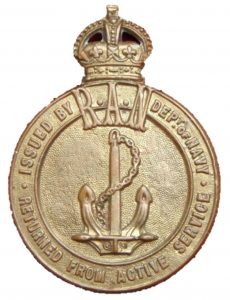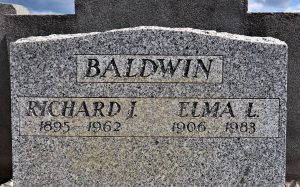Richard Joseph Baldwin (Service No. 3146)
(1896 - 1962)
 Richard Joseph Baldwin was born on 7 January 1896 to parents Patrick Baldwin and Ellen Baldwin (nee Cantwell) in Laverton. His parents, Patrick and Ellen, had migrated from Waterford, Ireland, in the mid-1880s and settled in the newly established town of Laverton in Alma Avenue. Richard was the second youngest of six children who all would have attended the Laverton state school.
Richard Joseph Baldwin was born on 7 January 1896 to parents Patrick Baldwin and Ellen Baldwin (nee Cantwell) in Laverton. His parents, Patrick and Ellen, had migrated from Waterford, Ireland, in the mid-1880s and settled in the newly established town of Laverton in Alma Avenue. Richard was the second youngest of six children who all would have attended the Laverton state school.
Richard left school in approximately 1910. He quickly gained employment at the Government explosives reserve situated on Queen Street, halfway between Laverton and Altona. He was also an inaugural member of a Laverton football team established in 1913, which would go on to join other local teams in the newly formed Werribee League.
On 16 June 1913, Richard joined the Royal Australian Navy and began his training on the HMAS Cerberus, which was, at that time, stationed at Williamstown. His initial ranking was Ordinary Seaman Second Class, and he spent three months on Cerberus before being posted to the HMAS Parramatta. The Parramatta was a ‘River’ Class torpedo boat destroyer, one of six that had been acquisitioned by the newly formed Australian Navy.
On 4 October 1913. with Richard aboard, the HMAS Parramatta took part in a formal fleet entry into Sydney Harbour to welcome the arrival of the new battlecruiser, the HMAS Australia. Richard ultimately spent three months at sea aboard HMAS Parramatta before returning to Williamstown and the HMAS Cerberus to complete his naval training. It was during his final training period that Richard turned 18 (7 January 1914) and advanced to the ‘Men’s Rating’ of Ordinary Seaman.
Following the completion of his training, Ordinary Seaman Baldwin was posted to the HMAS Melbourne on 27 April 1914. He was again at sea, involved in training cruises and visitations to key ports around Australia. The HMAS Melbourne was a ‘Town’ class light cruiser that had only been commissioned the previous year, having been built in England before being employed into the Royal Australian Navy. On board the HMAS Melbourne with Richard was Stoker Frederick Cations[1] from Werribee. It is uncertain whether they knew of each other prior to sharing a post on the HMAS Melbourne, or whether they became acquainted through work, as the cruiser had a crew of 454 sailors.
For the two months after war (now known as the Great War or World War 1) was declared, the HMAS Melbourne operated with other Australian warships in the Pacific as a counter to the German/East Asia Squadron. They were involved in the capture of several German Pacific Island colonies. On 20 September, the HMAS Melbourne returned to Sydney to resupply, and then on 1 November, she joined the escort of the convoy transporting Australian and New Zealand troops to Egypt.
As the convoy passed Colombo, the HMAS Melbourne was ordered to leave it and proceed to the Atlantic Ocean, and on to Gibraltar, to assist in the search for the German cruiser SMS Karlsruhe. By the time she reached there, on 12 December, the HMAS Melbourne was reassigned to Bermuda as a component of the United Kingdom’s North America and West Indies Station. Here, with Richard Baldwin aboard, the HMAS Melbourne and HMAS Sydney patrolled the islands of the West Indies, as well as the east coast of North America. It was during this time, on 29 July 1915, that Richard was promoted to the rating of Able Seaman.
In August 1916, the HMAS Melbourne sailed for Devonport in England. She spent a month here in port before joining the 2nd Light Cruiser Squadron of the British Grand Fleet, stationed at Scapa Flow. From January to June 1917, the HMAS Melbourne was docked at Birkenhead, England, for major repairs to her propulsion system. Whilst there, the cruiser was also fitted with an aircraft platform in November 1917. On 1 June 1918, the HMAS Melbourne launched her aircraft after sightings of a German aircraft over Heligoland Bight, but the pilot lost his target in the clouds. At the surrender of the German High Seas Fleet, the HMAS Melbourne was assigned to escort the SMS Nürnberg. The cruiser remained with the Grand Fleet until 30 November 1918. During the entire war, the HMAS Melbourne was not involved in any sea battles. Her only actions were those in the Pacific where she captured several German colonies.
On 7 March 1919, the HMAS Melbourne departed from England and sailed directly to Sydney, arriving on 21 May 1919. Able Seaman Richard Baldwin was then able to take leave, on home soil, and he took time to visit his family in Laverton. During his visit, he was welcomed home at a ceremony held in the Werribee Mechanics Hall on 25 June 1919. He was one of many local men who were presented with a Werribee Shire Gold Medal. His citation stated that he had served on the HMAS Melbourne in both the West Indies and in the North Sea.
Richard’s ship, the HMAS Melbourne, was ‘paid off’ in Sydney on 5 August 1919 and remained there ‘inactive’. In need of a new ship, Able Seaman Baldwin was transferred to the HMAS Australia and remained aboard her until 9 April 1920. Due to post-war budget cuts, the HMAS Australia only operated as a training ship before being placed in reserve. Richard had now only two months of his seven-year enlistment to run, and as the HMAS Melbourne was about to be recommissioned into the fleet, he was reassigned to his old ship. On 15 June 1920 in Williamstown, having completed his seven-year term of engagement, Richard was discharged from the Royal Australian Navy.
Richard initially returned home to Laverton, but shortly after he took up a position living and working as a labourer on the Metropolitan Farm in Werribee. Richard remained there until around 1932. He then took up employment at the Government explosives reserve and moved to Blyth Street in Altona to live.
In 1939, Richard Joseph Baldwin married Elma Lilleen Lane. The couple moved into Richard’s property at 73 Blyth Street, while he continued with his employment at the explosive reserve as a labourer. Elma Lane was the daughter of Robert William Lane and Lillian Alice Lane (nee Roberts), born in Carlton around 1905.
The couple lived and worked in Altona for the remainder of their lives, with Richard working at the Government explosive reserve, as well as being the magazine assistant. On 11 October 1962, at his home on Blyth Street, Richard passed away at the age of 66 and was interred within the Williamstown cemetery. Elma continued to reside at the family home, in Blyth Street, until her passing in September 1983. Elma Baldwin is buried alongside her husband within the Williamstown cemetery.
[1] http://www.wyndhamhistory.net.au/items/show/1597
